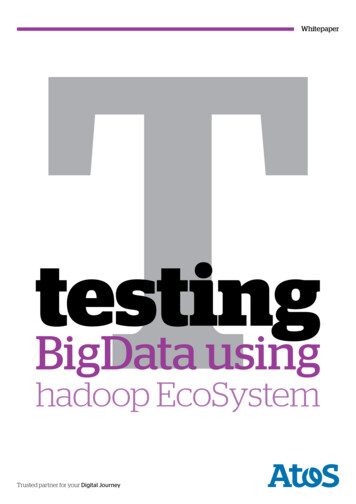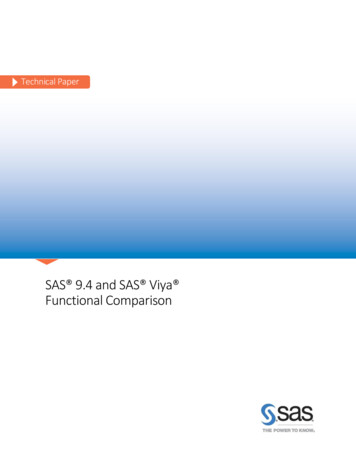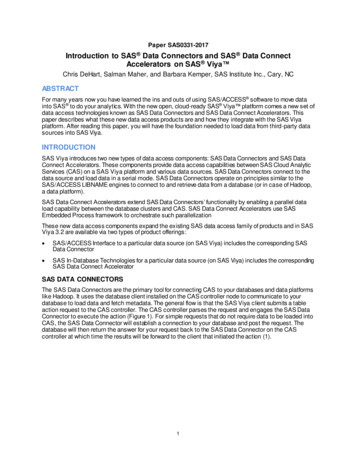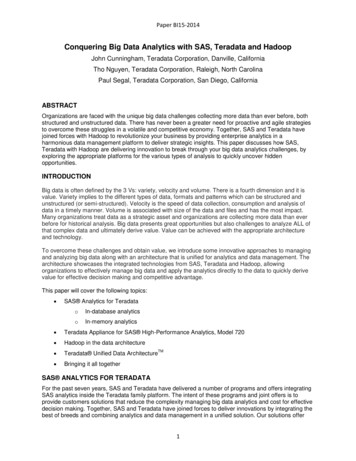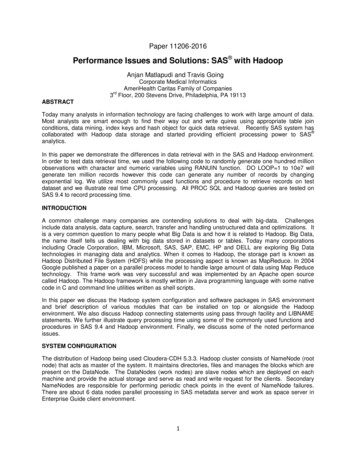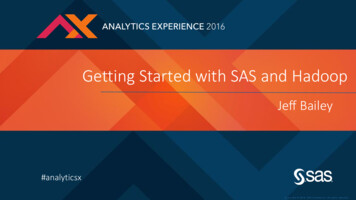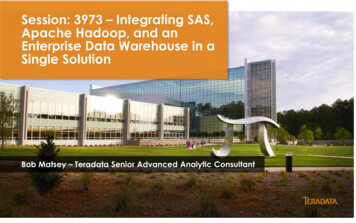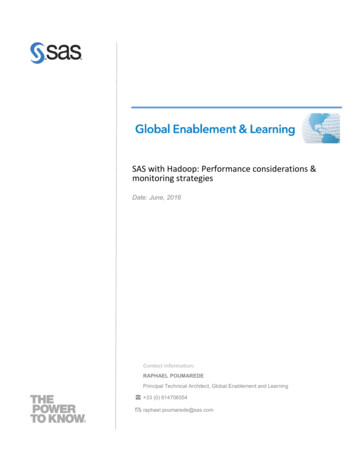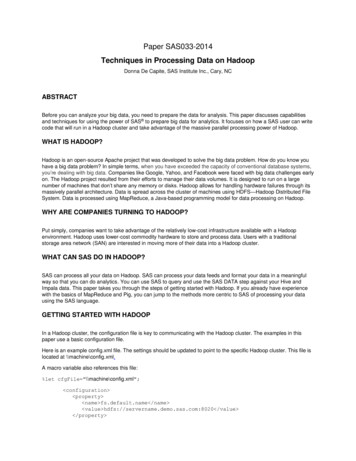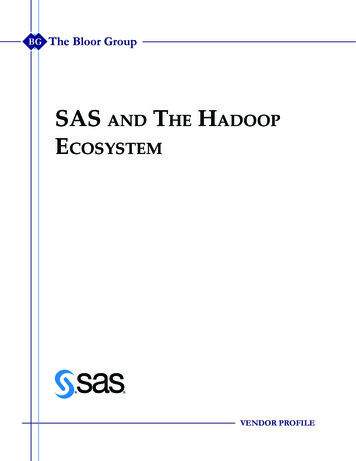
Transcription
The Bloor GroupSAS and The HadoopEcosystemVENDOR PROFILE
SAS and The Hadoop EcosystemOur research indicates that, at the current rate of adoption, Hadoop and its ecosystem willbecome dominant in the area of analytics and BI applications for the enterprise environment.This could constitute as much as one third of enterprise IT in the near future. Despite theextensive and growing stack of capabilities in the Hadoop ecosystem, there are still significantgaps. Software companies like SAS are filling many of those gaps and dramatically improvingits overall functionality for data management, data visualization and analytics activities.This paper will discuss the qualities of SAS software and how it can enhance a Hadoopimplementation.The SAS Big Data ArchitectureThe SAS brand is inextricably tied to analytics. Incorporated in 1976, SAS has long been anindustry leader in the analytics and data management market. Due to the current trend towardHadoop platforms dominating the realm of analytics and BI, SAS and Hadoop would seem likecompetitors. However, SAS has evolved instead to be a powerful complement to the Hadoopecosystem. In recent years, SAS has heavily modified their products or launched new ones toaugment the Hadoop ecosystem and expand the reach of SAS customers into the rich data setsthat reside in Hadoop clusters.To their suite of analytics products, SAS has added parallelized algorithms and severaltechniques to accommodate cluster or distributed computing needs. SAS has embraced thephilosophy of minimizing data movement by pushing the SAS compute engine out onto theHadoop cluster. The new technology reads data on the cluster into an in-memory store on thecluster itself, where the SAS compute engine can then do multiple parallel operations on it.Leading-edge parallel algorithms have been developed to work against this in-memory dataset on the cluster. The in-memory structure allows the algorithms to operate on the data atimpressive speeds and return results in very short time frames. Modern data visualization andmachine learning algorithms have been developed, including data mining, predictive analysis,text mining, forecasting and optimization.The SAS suite of Hadoop-related products includes SAS Data Management offerings, SAS InMemory Statistics, SAS Visual Analytics and SAS Visual Statistics and the suite of SAS HighPerformance Analytics products (High-Performance Statistics, High-Performance Data MiningHigh-Performance Text Mining, High-Performance Econometrics and High-PerformanceOptimization). These sets of products were created specifically to meet the different needs ofdata scientists, statisticians and business analysts working in Hadoop environments. SAS InMemory Statistics offers an interactive programming environment, wherein multiple users canexplore data, design data preparation workflows, design analytic models, test them iterativelydirectly on the cluster, compare them, score them and deploy them when complete. SAS VisualAnalytics and SAS Visual Statistics together offer an interactive, drag and drop environmentfor visual data discovery, interactive reporting and predictive analytics. The SAS HighPerformance Analytics products enable distributed processing for sophisticated analytics ondistributed data in Hadoop for Statistics, Data Mining and Machine Learning, Text Mining,Optimization and Econometrics. They can be accessed through an interactive programminginterface and also are tightly integrated with graphical analytical workbenches, such as SASEnterprise Miner and the new SAS Factory Miner.At no point in the process is data removed from the Hadoop cluster. In fact, if it is advantageousto combine other data sets, such as EDW data sets, SAS operators pull that data onto the Hadoopcluster so that the SAS data processes can make use of the cluster’s computational power andmassive storage capacity.1
SAS and The Hadoop EcosystemFigure 1. SAS In-Memory Analytics and Data Management for Hadoop in OverviewIn our view, the four main advantages that SAS provides in combination with Hadoop are:1. Sophisticated parallel optimized analytic algorithms2. In-memory processing of data for machine learning and data integration3. Data management and data quality processing for all data in Hadoop and associatedsystems4. Interactive visualization and exploration of data both in Hadoop and in combination withother systems, such as data warehousesSAS Addresses Specific Weaknesses in HadoopSAS analytics and data management tools use the cluster storage, interact with the HadoopDistributed File System, Hive and/or Impala and HCatalog and use the cluster’s computationalpower. It does not require any specific Hadoop distribution, or even require Hadoop at all, butit is designed to function well either beside a Hadoop cluster or within a Hadoop cluster, asillustrated in Figure 1. Still, one might logically ask why it would make sense to use SAS withHadoop.Several weaknesses in the Hadoop platform have been identified as its adoption rate hasincreased. These weaknesses have stalled Hadoop projects or prevented Hadoop adoption inmany cases. SAS has specifically sought to address these weaknesses.The shortage of skilled MapReduce coders in the current marketplace is well known. SASaddresses this problem with graphical drag-and-drop interfaces that allow the definition ofdata preparation and analytics workflows. These graphical workflows can be designed bynon-programmers and can use the MapReduce framework to profile, prepare, transform, andcleanse data in parallel across the cluster.SAS also addresses the shortage of Hadoop skills by providing a wide range of pre-built analytic,data quality and data preparation procedures. SAS has over the last years and continues toengineer these procedures to take full advantage of massively parallel Hadoop environments.Even the sophisticated SAS machine learning algorithms run smoothly in Hadoop, which2
SAS and The Hadoop Ecosystemaddresses the shortage in the Hadoop ecosystem of mature, capable, parallel algorithms.MapReduce is very batch oriented, and in many ways, not appropriate for iterative, multistep analytics algorithms. In particular, its strict paradigm of doing a shuffle and write to diskbetween each step in a process would cause multiple intermediate files to be created. This ishighly inefficient. By pulling the Hadoop data into an in-memory format, SAS In-MemoryStatistics and SAS Visual Analytics, for example, provide algorithms that can apply to multiplesteps without touching disk. This vastly increases the productivity of data scientists andbusiness analysts.One of the difficulties associated with the Hadoop data lake architecture is gaining an initialunderstanding of the content, combinations and potential correlations of all the many typesof data stored there. SAS provides an interactive environment for analytic exploration andvisualization. The SAS interface allows both visual and SQL-style interactive querying ofthe data without any requirement to write code. The interface generates Hive QL, a nativequerying language for Hadoop. While no coding is required, power users may enter Hive QLdirectly if they wish.The shortcomings of Hadoop in the areas of data security and management are also wellknown. SAS has a federation capability that helps mitigate this weakness. By creating avirtual data layer, role-based access, data masking and many other security measures that canbe implemented between the data and the users. This layer can also be a virtual integrationenvironment that combines data from the Hadoop cluster and other data sets, such as the datawarehouse.This federation capability also simplifies and augments the Hadoop interactive experience byabstracting away much of the complexity of the Hadoop data environment. SAS has a wellestablished user community that can now use this familiar environment to leverage the powerof Hadoop. The wide variety of Hadoop data sets can become simply another data source forSAS. This, too, helps address the shortage of Hadoop-related skills.One inherent weakness of the Hadoop data lake concept is that data is often stored withoutregard to its usefulness or quality. The old adage of “garbage in, garbage out” still holds truein the modern world of massive, widely-varied data sources. Several of the Hadoop specificoperators in SAS are designed for fast parallel data access and for performing data profiling,data quality and data integration tasks directly on the Hadoop cluster. This provides quality,vetted data for analytics, improving the eventual accuracy of the analyses done on that data.While addressing these weaknesses of Hadoop, SAS has also sensibly exploited the fundamentalstrengths of the Hadoop platform. SAS pushes the analytic processing to the data rather thantrying to move the data elsewhere for processing. When other data sets are needed, copies ofthat data are pulled into the Hadoop cluster to take advantage of both the Hadoop cluster’smassive storage capacity and the cluster’s sheer parallel compute power. Additionally, to meetcustomer demands, SAS has aligned its Hadoop strategy and roadmap to support varietyof Hadoop distribution partners like Cloudera, Hortonworks, MapR, IBM BigInsights, andPivotal.SAS and Hadoop Use Cases3
SAS and The Hadoop EcosystemThe intersection of capabilities provided by the combination of the Hadoop ecosystem andSAS offerings lends itself logically to specific business use cases. This software is ideal foranalytics intensive workloads, not just data or compute intensive workloads. It is well-suitedto the data lake architectural concept, meaning “a repository for data which supports andsupplements a data warehouse.” Hadoop alone is not capable of providing the optimizedperformance associated with a data warehouse. It requires complementary data warehouseand sophisticated analytics capabilities alongside it.In cooperation with the Hadoop platform, SAS provides several unique capabilities. With thetwo platforms operating in tandem, users have the ability to leverage diverse data sets andevaluate multiple analytic scenarios to zero in on the best fit for the job at hand. Situationswhere we see this combination of SAS and Hadoop software as particularly advantageousinclude: Analytic sandbox implementations, where new data may be combined with existingdata – possibly data warehouse data – then understood and analyzed to see if it yieldsuseful new insights. The SAS software is particularly well-suited to support in an easy,integrated and comprehensive way the many different activities that data scientistsand business analysts have to apply to extract actionable insights from data in Hadoop– ranging from data wrangling and data cleansing, to discovery and exploratory dataanalysis, the application of machine learning for model development and the deploymentof models for operationalized analytics – all directly in Hadoop environments. Self-service large scale business intelligence type implementations, where nonprogrammers need to explore large and diverse data sets via interactive querying ina visual environment. This technology can also be used to offload many BI workloadsfrom overworked data warehouses. Active archive types of implementations. In these cases, data that may no longer befresh, but may still contain long term pattern insights, can be archived away from theexpensive storage of the data warehouse and be accessible for long term analysis.These are the general architectural use cases that we believe this combination of softwareplatforms is well-suited for. These general use cases can be put to work to solve a varietyof business problems, including insurance underwriting, risk mitigation, fraud detection,customer behavior analytics, location based marketing, cyber security, recommender systems,bandwidth allocation, network quality analysis and a wide variety of other business problems.Organizations who are already invested in SAS – or organizations looking to add a robustHadoop component – would do well to consider the SAS suite of Hadoop-related solutions.To learn more about SAS and the research used in this paper, please visit www.sas.com/bloorreport.4
SAS and The Hadoop EcosystemAbout The Bloor GroupThe Bloor Group is a consulting, research and technology analysis firm that focuses on openresearch and the use of modern media to gather knowledge and disseminate it to IT users.Visit both www.TheBloorGroup.com and www.InsideAnalysis.com for more information.The Bloor Group is the sole copyright holder of this publication.Austin, TX 78720 512-524–3685SAS and all other SAS Institute Inc. product or service names are registered trademarks or trademarks of SAS Institute Inc. in the USAand other countries. indicates USA registration. Other brand and product names are trademarks of their respective companies.108004 S146869.1115
Hadoop platforms dominating the realm of analytics and BI, SAS and Hadoop would seem like competitors. However, SAS has evolved instead to be a powerful complement to the Hadoop ecosystem. In recent years, SAS ha
